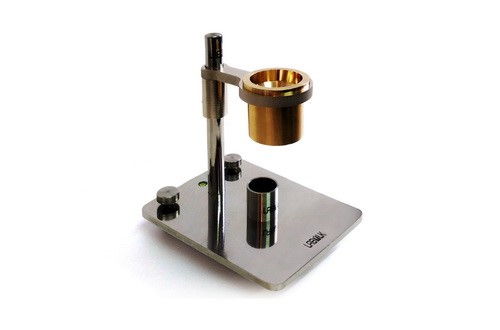Flowability test: Hall or Carney cone in laboratory

The flowability test is a measurement method to determine the flowability of a powder. For metallic powders, the test is performed with a Hall cone or a Carney cone.
The flowability test consists of measuring the time required for a given quantity of metal powder to flow through an orifice calibrated according to specific standards:
- ASTM B213 and ISO 4490 for the Hall cone
- ASTM B964 for the Carney cone.
Indeed, and particularly in the additive manufacturing sector, the flowability impacts the coating of the powder bed as well as its density. The flowability test therefore ensures the proper spreading of layers during powder bed processes.
The Carney cone test is recommended for powders that do not flow easily through the Hall funnel.
FILAB supports you in your flow analysis needs
FILAB offers to industrialists flowability measurements on metallic and ceramic powders, under real production conditions. We have a Hall cone and a Carney cone to adapt to your specifications.
These two instruments complete a wider range of analytical equipment dedicated to the physico-chemical characterization of metallic powders:
- Flowability measurement by Hall Cone or Carney Cone
- Analysis of the chemical composition of a metal powder by ICP and C/H/O/N/S analyzers
- Particle size characterization
- Measurement of apparent or tapped density
- Morphological control by SEM-FEG and MO
The angle of repose of a powder is defined as the maximum angle at which a material can be stacked without it sliding down or collapsing. It is determined by measuring the angle between the horizontal plane and the surface of the stack. In general, this angle depends on several factors such as the size and shape of the particles and the inter-particle forces. It is an important parameter for determining various powder characteristics such as flowability, compressibility and storage stability. Angle of repose analysis also provides useful information for process design in industries dealing with bulk materials such as pharmaceuticals and food processing. The measurement of the angle of repose uses a variety of techniques, including plotting data points on graph paper after sieving particles smaller than 0.5 mm.
The analysis of the angle of repose of a powder is important because it helps to determine the flowability, compressibility and storage stability of the material. A low angle of repose means that the material can be easily poured or retrieved at any angle, while a high angle indicates that it is more difficult to move. Knowing this information can help industries dealing with bulk materials, such as pharmaceuticals and the food industry, to design efficient processes for their products. Understanding how different particles interact with each other and their individual characteristics allows engineers to find better solutions for managing and storing powders. For example, analysing the slip angle of a powder provides valuable information on many aspects of bulk material handling.
Yes, there is a difference between powder angle of repose analysis and powder angle of repose analysis. Powder angle of repose analysis measures the internal friction of a stack by measuring the maximum angle at which particles can be stacked without slipping or collapsing. The powder angle of repose analysis examines how particles flow when pushed from one point to another and assesses their ability to move as a solid mass. It is important to note that the two tests measure different things, so it is essential to perform both tests to get an accurate assessment of the material's properties. Some materials have different angles depending on their orientation; for example, sugar has a higher angle in its horizontal position than in its vertical position.








